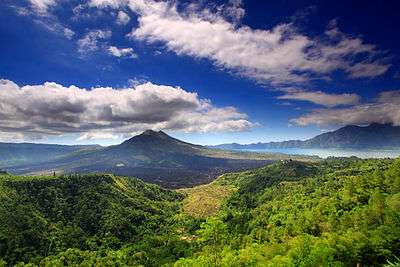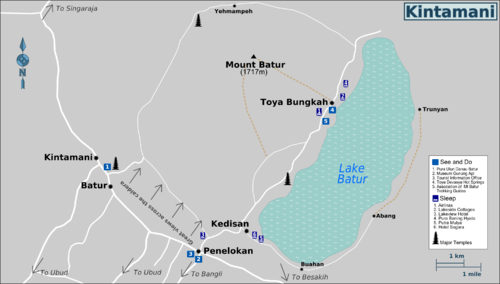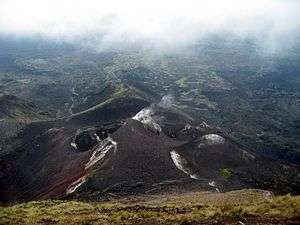Kintamani
Understand

The area of north-eastern Bali at the Mount Batur caldera, and which encompasses Penelokan, Toya Bungkah, Batur and Kintamani villages, is known widely as just Kintamani. Kintamani, Batur and Penelokan villages sit on the rim of the huge Batur caldera about 1,500m above sea level, and offer dramatic views of the active volcano Mount Batur and serene Lake Batur. Toyo Bungkah village is down at the lake edge.
As well as the lake and the volcano, Kintamani is home to Pura Ulun Danu Batur, one of Bali's key nine directional temples.
Climate
You are high in the mountains of Bali here and the temperature is usually about 15 degrees cooler than down on the coast, and even more so at night. That, coupled with the often cloudy and drizzly weather, makes a sweater or jacket advisable in the day time and vital after sunset.
Tourism Information Office
- Yayasan Bintang Danu, Penelokan (on the crater rim road, close to the turning down to the lake edge), ☎ +62 366 51730. 10AM-3:30PM daily. This is a private office run by a local charity, so if they are helpful, please consider a donation.
Get in

By car
Kintamani is usually approached from the south with 2 routes in from Ubud (45 minutes), and one each from Besakih (1 hour) and Bangli (30 minutes). There is also an easy way in from the north via a turning off the coast road east of Singaraja (1 hour). All private vehicles pay entry charge to get into the area of Rp 10,000 per person. Keep the ticket as this is valid for the whole Kintamani area, and you may be asked to show it again.
From the popular tourist destinations in South Bali, a trip to Kintamani by car will take 90 minutes plus.
By bus or bemo
There are daily shuttle bus services from Ubud which are widely advertised locally there. Book 24 hours in advance.
Kintamani is served by bemos and buses from Batubulan terminal in Denpasar for about Rp 25,000. These are torturously slow though.
Organised tours to this area are widely offered in all major centres of Bali.
Get around
Not too many visitors choose to stay in this area, but instead view the local sites by car or motorbike in the course of a day.
Bemos do ply the caldera road between Penelokan and Kintamani villages. Look for the orange vans and expect to pay about Rp 10,000 for any local journey. With the climate being quite cool up here, the area makes for pleasant walking.
See
The main attraction for visitors is located around Lake Batur where Penelokan village provides spectacular views of this crater lake and Mount Batur, set in a vast volcanic caldera. Photo opportunities abound, but try to be there as early in the morning as you can manage before the cloud inevitably starts to gather.
Further northwest along the rim of the caldera is Pura Ulun Danau Batur, one of the most important temples in Bali. Entry is by donation here - Rp 10,000 is about right. The temple was rebuilt up on the caldera ridge in 1926 after an eruption of Mount Batur destroyed the old one down in the crater. There are a large number of shrines, but most visitors are drawn to the huge eleven roofed meru in the inner courtyard. This is dedicated to the goddess of the lake, Ida Batara Dewi Ulan Danau who is regarded as the controlling deity of the whole water and irrigation system of Bali. A virgin priestess is resident at the temple to represent the goddess, and she is served by 24 priests who are chosen as young boys and then keep the role for their lifetime. This is a strong example of just how importantly water and irrigation matters are regarded in traditional Balinese culuture.
You can visit the Bali Aga village at Trunyan on the eastern shore of the lake by boat from Kedisan. This is recommended in some guides, but first hand reports are frequently negative and speak of some problems. This is an isolated community and one which is not particularly welcoming to tourists, despite relying on income from visitors. If you really must go, catch a boat at the lakefront in Kedisan (or you can charter a boat from Toyo Bungkah) and make sure the price is clearly understood before departing, and that the entrance donation to the Trunyan villagers is included. When you arrive at Trunyan, the key attraction is the cemetery. Ancient customs retained by the Bali Aga here include the open burial of dead bodies in a pit covered by just some light cloth. If you want to visit a Bali Aga village though, then Tenganan near Candidasa is a far better option.
One of the best things about a visit to Trunyan is the views of Mount Batur from the eastern shore of the lake. This provides a very different perspective from the usual view from the crater rim. You can though get those same views by taking the small road around the southern edge of the lake through the villages of Kedisan (where there are a few simple places to stay and eat), Buahan and on to the tiny settlement of Abang. The road ends at Abang, a four wheel drive vehicle is more appropriate for this skinny and at times very steep road(but you can explore the eastern shore of the lake further on foot, all the way to Trunyan (about 4 km) if you are feeling energetic (you will be stopped by locals along the way asking if you want to go to Trunyan, they may even follow you and tell you that you cannot go there on foot and you must take a boat with them. Take plenty of water for the walk and be prepared for steep hills.
- 🌍 Batur Geopark Museum (Very close to the junction where the road from Bangli meets the main caldera rim road at Penelokan.), ☎ +62 361 67678, e-mail: info@baturglobalgeopark.com. 10PM to 5PM Mo to Fr. Well presented exhibits here include explanations of the pacific ring of fire and Indonesia's position within that, local vulcanology and the history of eruptions of Mount Batur, volcanic rocks collected locally, films and computer animations explaining why volcanoes erupt and a telescope to view the mountain. Definitely worth a visit.
Do

Climbing Mount Batur
A climb to the summit of Mount Batur - 1,700 metres and still an active volcano - to watch the sunrise is a great experience for more energetic travellers. This is a very easy climb of about 2 hours, and local guides abound; they are really not necessary for such light climbing, but you are required to hire one, anyway. Which parts of the mountain are safely accessible change according to local volcanic activity.
All guides are members of the Association of Mount Batur Trekking Guides, which has an office in Toyo Bungkah village (tel: +62 366 52362, 3AM-1PM), from where the treks commence. Book at the office or ask to see proof of membership to avoid problems later, and expect to pay Rp 300,000 to 400,000 per guide. The fare is very expensive compared to the entrance fee for Bromo-Tengger-Semeru National Park in East Java. The association runs a cartel on climbing the mountain, and even if you have successfully scaled Everest, you will be obligated to hire a guide for this fairly low key, simple trek. If you do not book through the association you may be confronted at the start of the climb by the guides; if you do not then pay them, they are known to become aggressive and confrontational.
Use your common sense with the weather, but bear in mind that the paths become very slippery when it is raining, and climbs should be avoided altogether in the depths of the wet season (December to February especially).
There are two commonly used ascent routes. Both are about the same length, but by far the best is from Toya Bungkah itself, as more than half of the climb is through pleasant shady forest. The alternative route from Pura Jati is across ancient lava fields, there is no shade whatsoever, and underfoot conditions can be harsh. Longer treks of up to 10 hours are also available. These get you right off the beaten path, and will appeal more to serious trekkers. One rewarding option is to scale Mount Abang on the south eastern edge of the outer caldera. Ask at the guides association office. To avoid the hassle of constant harassment by touts in the area asking high prices to guide you, book before you arrive in the area. Most hotels in the area do packages including accommodation in the area or book with your hotel and be driven up in the middle of the night.
C.Bali Tours, Suggestion: Book ahead with a hotel listed below (who can arrange a guide). Then when you come to the area just tell the touts that follow you that you already have a booking and guide so they will leave you alone. C.Bali don't wish to see tourists paying inflated prices or being hassled, sometimes bullied.
Pre-dawn climbs timed to reach the peak at sunrise are popular, and also give you the best chance of avoiding the cloud which often envelopes the mountain from mid-morning onwards. From the peak of the mountain the views in all directions are quite splendid. The sun rises over much higher Mount Agung to the east, while the northerly aspect back towards the crater rim road takes in a large volcanic ash slope with several steaming, active cones. A popular little gimmick from the guides during the climb is to cook an egg on lava-heated rock. Fun, but also a stark reminder of just how active this volcano is.
Other things to do in this area
- C.Bali Canoeing & Cycling Tours (C.Bali), Front of Segara Hotel, Kedisan Village, e-mail: info@c-bali.com. The only company offering Canoeing tours on Lake Batur and cycling and cultural tours through the villages around the lake. If you don't want to deal with the annoying touts in the area, this company will pick you up from the South and bring you up for the day to experience this beautiful area. Prices including transport start from Rp 430,000 including all meals, drinks, transport and activities. If you do one of their tours C.Bali can also organise trekking of Mt Batur as an add on (but not as a separate activity).
If (and that's a big if) it is passable, the road which circumvents the base of the crater is very much worth a drive. You get some very different perspectives of the mountain from here. From Toya Bungkah the road loops north around Mount Batur, through Yehmampeh, past another important temple called Buki Mentik and then up again rejoining the caldera ridge road between Kintamani and Batur villages. This road is though often so damaged as to be impassable except on foot. You can walk the whole circuit but it is a long trek - about 18 km if you start from the caldera road.
Downhill cycling tours from Kintamani back to Ubud are offered by several operators on the island including Bali Sobek , Bali Adventure Tours and BikeBali . This is a relaxing way to explore the pleasant mountain and hill country between Kintamani and Ubud. The tours normally commence mid-morning from Kintamani, include a lunch stop, and the total duration is 4-5 hours. Expect to pay about Rp 400,000 per person including all equipment, water and lunch.
- Toyo Devasya, ☎ +62 366 51204. 8AM-8PM. Soak in these hot springs right by the lake side in the village of Toya Bungkah. Very relaxing, and a great way to warm up on the frequent chilly days up here. US$10 including use of loungers.
Buy
Kintamani is the pushy souvenir hawker capital of Bali. They will surely target you the moment you arrive and try to admire the view. If you are confident handling the haggling with these vendors, Kintamani can turn out to be an interesting shopping experience. If you are not, and allow such things to bother you, the level of hassle here can make for an unpleasant experience.
Fruit and vegetables. Kintamani is renowned for growing oranges (especially) and other fruit. You will see lots of streetside vendors in this area selling excellent quality freshly picked fruit. The local orange is called Jeruk Kintamani and is delicious. The areas down around the lake (especially on the eastern shore) are market gardens for all sorts of cool climate vegetables.
Eat
There are a large number of identikit buffet restaurants sited on the main road in Kintamani and Penelokan. These are aimed at tour buses. These restaurants offer fantastic views across the lake, and serve all-you-can-eat lunch buffets at acceptable prices. You could instead head for local food stands and other outlets close to Kintamani market and smaller restaurants in Penelokan.
In Toya Bungkah there are several small restaurants that specialise in locally caught fish from Lake Batur.
Drink
There are no bars here at all. If you are staying at Toya Bungkah you might well run into other travellers keen to exchange chat, and have a few beers by the lake.
Sleep
Few visitors stay in the area but instead take in the sights during the day. Those that do stay do so for the purpose of climbing Mount Batur pre-dawn, and therefore stay down around Lake Batur close to the ascent start point in Toya Bungkah or at Kedisan on the southern shore.
- Arlinas, Toya Bungkah, ☎ +62 366 51165. Something of an institution in Toya Bungkah, and popular with budget travellers. Located next door to the trekking guide association office. You can chose whether you want hot water or not (costs extra), and the rooms have nice verandas with lake views. About 500.000rp 2person.
- Batur bungalows, Toya Bungkah-Songan, e-mail: baturbungalows@gmail.com. Check-in: 14.00, check-out: 12.00. New bungalow directly at the foot of Batur volcano. Spacious and clean rooms with views of the Batur. A 15 minute walk to Lake Batur and hot springs in Toya Bungkah village. About Rp 400,000.
- Lakeview Hotel & Restaurant, Penelokan village, Bali (on the Caldera Road at Penelokan), ☎ +62 366 52525, e-mail: reservations@lakeviewbali.com. Few overseas visitors ever stay on the Caldera Ridge Road but if you decide to, this is the nicest of the bunch of hotels there. Amazing views, but a strange almost fortress-like design. From Rp200,000.
- Batur Lakeside Hut, Kedisan Kintamani (on the caldera road at Penelokan), ☎ +62 81337536464, e-mail: info@baturlakesidehuts.com. Check-in: 13.00pm, check-out: 12.00pm. Balinese Hut. Not very well maintained. From Rp650.000.
- Puri Bening Hyato, Toya Bungkah, ☎ +62 366 51234. Located a little to the north of the other places to stay in Toya Bungkah. The more expensive rooms have hot water, and there is a communal hot spring-fed jacuzzi. From Rp 120,000.
- Putra Mulya, Kedisan, ☎ +62 366 51754. Very simple and cheap rooms and this place on the south shore of the lake which is popular with backpackers for that reason. Rp 70,000.
- Segara Hotel & Restaurant, Kedisan, ☎ +62 366 51136, e-mail: hotelsegara@hotmail.com. A variety of rooms here, most with hot water and even some with TVs (local channel only). Decent restaurant, internet available, nice views of the lake, and a good source of reliable trekking guides. Ask to see one of their new rooms as they are slowly renovating. From Rp 200,000.
Connect
The area code for Kintamani is 0366.
- Internet access has finally arrived in this area, and the better places to stay in Kedisan and Toya Bungkah offer internet facilities for non-guests.
- There are public telephone offices at Penelokan close to the turn off down to the lake, at Kintamani market and in Toya Bungkah.
Go next
- Onto the north coast to Singaraja and quiet beaches at Lovina.
- The cultural heartland of Bali in Ubud is just 45 minutes to the south.